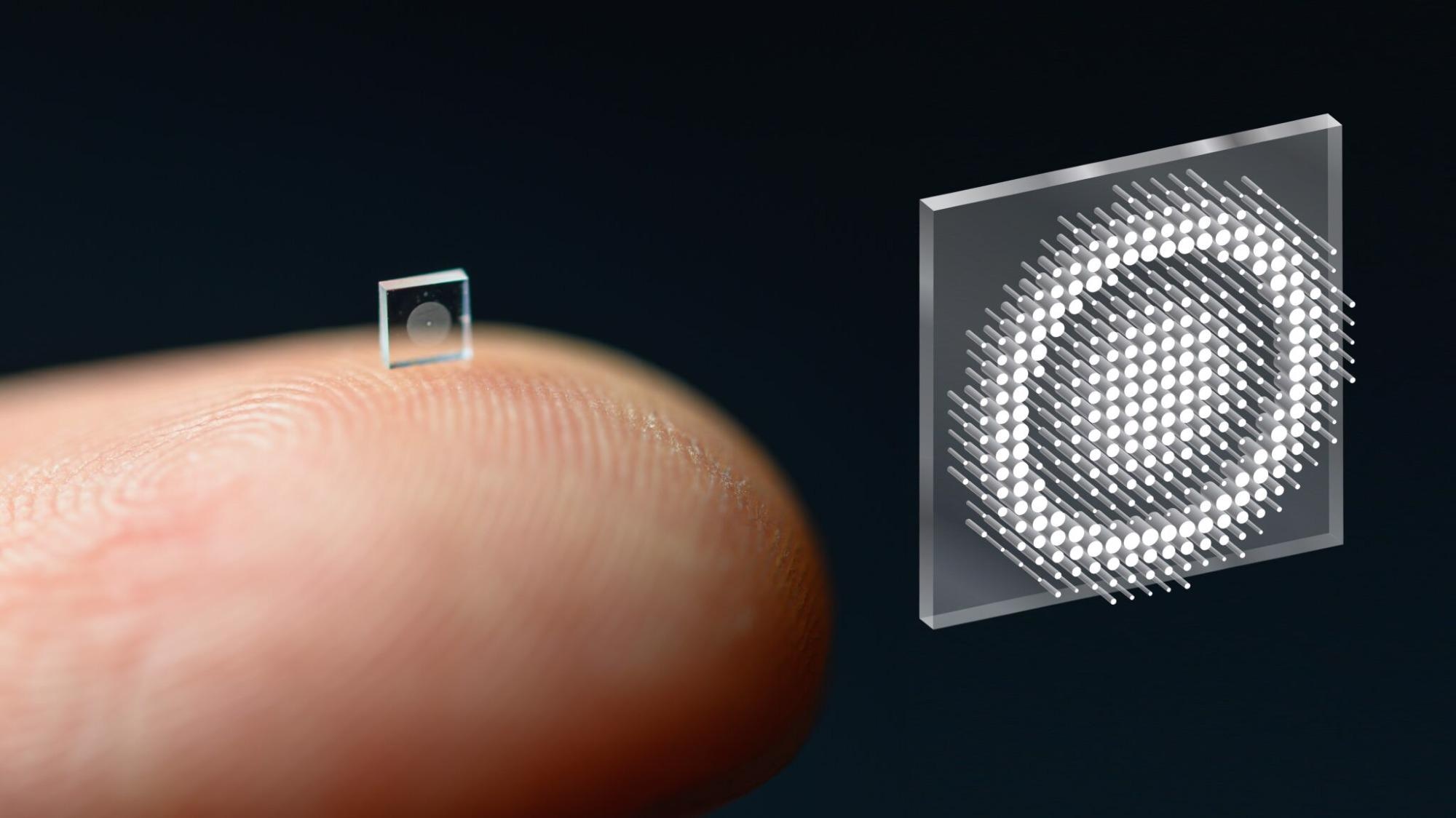Researchers at Princeton University and the University of Washington have developed a full-color nano-camera the size of a grain of salt. 1.6 million cylindrical nano-posts were etched on a silicon nitride layer. A neural image reconstruction algorithm manipulates the morphology of these nano-posts to create wide field-of-view (FOV) full-color images.
 Image Credit: Princeton University, Sharlach, M. (2021) Researchers Shrink Camera to the Size of a Salt Grain. [online] Available at: https://engineering.princeton.edu/news/2021/11/29/researchers-shrink-camera-size-salt-grain
Image Credit: Princeton University, Sharlach, M. (2021) Researchers Shrink Camera to the Size of a Salt Grain. [online] Available at: https://engineering.princeton.edu/news/2021/11/29/researchers-shrink-camera-size-salt-grain
Metasurfaces have been the subject of intense research for decades. Nano-optic devices operating at sub-wavelength scales could enable novel imaging applications in areas as diverse as robotics, virtual reality and in vivo health monitoring. Metasurface optics offer a path to such nano-imaging devices. However, existing methods achieve poor image quality compared to bulky refractive alternatives.
A Brief Introduction to Metasurfaces
A metamaterial is a material that has been engineered to display properties not found in naturally occurring materials. They are assembled from composite materials and arranged in patterns at scales smaller than the wavelengths of the phenomena which scientists seek to manipulate.
Thus, the properties of metamaterials are not derived from the properties of the component materials but from their structure. Their morphology, size and orientation give rise to unique properties in the presence of electromagnetic waves (light), allowing them to absorb, enhance or bend these waves in ways their constituent materials cannot.
Metasurfaces can be thought of as two-dimensional metamaterials. They first came to light in 1902 when Robert W. Wood discovered that reflection spectra of subwavelength metallic grating had dark areas, in a phenomenon known as Wood's anomaly.
This led to the discovery of surface plasmon polaritons (SPPs) which enable subwavelength optics beyond the diffraction limit. By modulating constituent nanostructures on metasurfaces, scientists can customize polarization, amplitude and phase in incident light.
What’s more, metasurfaces can be mass-produced by lithography, thin film deposition and etching techniques commonly used in semiconductor manufacturing, thus enabling the manufacture of metasurface optical components at scale.
Whilst a conventional camera uses a series of bulky glass or plastic lenses to bring rays of light into focus, the Princeton and Washington Universities team used optical metasurfaces. Each metasurface is just half a millimeter wide and is studded with 1.6 million cylindrical nano-posts approximately the size of an HIV virus.
Each nano-post’s unique geometry allows it to function in a similar way to an optical antenna. By fluctuating the design of each post, the team was able to modulate an optical wavefront. They used machine learning-based algorithms to model the posts’ interfaces with light and thus reproduce the highest-quality images and widest field of view for a full-color metasurface camera currently on the market.
The Road to Nanosized Optical Metasurfaces
Optical metasurfaces are showing potential in replacing bulky optical components. As they consist of sub-wavelength patterned layers, they interact strongly with light, significantly altering its properties at sub-wavelength scales. Thus, scientists can capture and re-emit light waves with a specific phase, polarization, modality and spectrum, enabling a high degree of precision in the modulation of light waves.
Although micron-sized sensors have already been used, further miniaturization has been hindered by the limitations of conventional optics. Approaches thus far have used a series of refractive lenses to correct for aberrations, but this places a lower limit on how far camera sizes can be reduced.
The multidisciplinary team used computationally designed metasurface optical elements to build an ultra-compact nano-camera. They developed a high-quality, polarization-insensitive nano-imaging technique for full-color (400 to 700 nm), wide FOV (40∘) imaging with an f-number of 2.
Compared to previous studies which relied on hand-crafted designs, they optimized the metasurface and machine learning algorithm with an end-to-end differentiable image formation model.
To date, no other metasurface optics-based approach has demonstrated a comparable combination of image quality, large aperture size, low f-number, wide fractional bandwidth, wide FOV and polarization insensitivity.
The team has demonstrated image quality on par with bulky, six-element compound lenses using a design that is 550,000 times smaller. Their computational reconstruction pipeline runs in real-time and requires only 58 milliseconds to process a 720 px × 720 px RGB capture. They achieved spatial resolutions of 214 lp/mm across all color channels at 120 mm object distances.
Such nano-configurable optics bodes well for future applications in reconfigurable optical metasurfaces, quantum metasurfaces, emitting and lasing metasurfaces, nano-robotics and medicine.
References and Further Reading
Tseng, E. et al. (2021) Neural Nano-Optics for High-Quality Thin Lens Imaging. Nature Communications, [online] 12, 6493 (2021). Available at: https://doi.org/10.1038/s41467-021-26443-0
Sharlach, M. (2021) Researchers Shrink Camera to the Size of a Salt Grain. [online] Available at: https://engineering.princeton.edu/news/2021/11/29/researchers-shrink-camera-size-salt-grain
Harvard. Metasurfaces and Flat Optics. [online] Available at: https://capasso.seas.harvard.edu/metasurfaces-and-flat-optics
Disclaimer: The views expressed here are those of the author expressed in their private capacity and do not necessarily represent the views of AZoM.com Limited T/A AZoNetwork the owner and operator of this website. This disclaimer forms part of the Terms and conditions of use of this website.